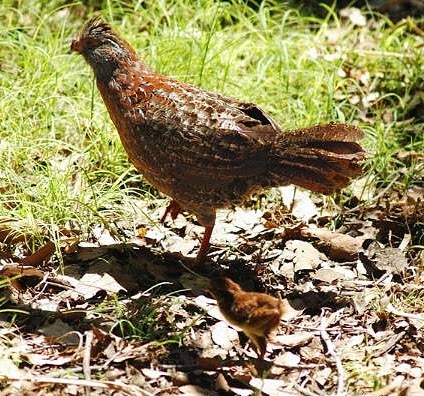 |
| (Photo from Polski Kurnik) |
Common name:
bearded wood-partridge (en); codorniz-de-Veracruz (pt); colin barbu (fr); colín barbudo (es); bartwachtel (de)
Taxonomy:
Order Galliformes
Family Odontophoridae
Range:
This species is endemic to Mexico, being confined to a few areas in Sierra Madre Oriental and Sierra Madre de Oaxaca, north and east of Mexico City.
Size:
These birds are 22-36 cm long and weigh 400-460 g.
Habitat:
The bearded wood-partridge is mostly found in moist, mountain evergreen forests and adjacent pine-oak forests with dense understorey, also using forest edges, second growths and shade coffee plantations. They are present at altitudes of 900-3.100 m.
Diet:
They feed on fruits, nuts, berries and other plant matter, as well as some small invertebrates.
Breeding:
Bearded wood-partridges breed in February-June. They are probably monogamous and nest in a deep depression on the ground, lined with palm leaves, where the female lays 4-8 dull white eggs which are incubated for 28-32 days. The chicks are precocial, leaving the nest soon after hatching, and become able to fly at 7-14 days of age. They reach sexual maturity at 1-2 years of age.
Conservation:
IUCN status – VU (Vulnerable)
This species has a relatively small and fragmented breeding range. The global population is estimated at 3.600 individuals and believed to be declining rapidly due to habitat loss and degradation. With the exception of the remote Sierra Gorda, most of the bearded wood-partridge range in affected by habitat destruction and fragmentation as a result of logging, clearance for agriculture, road-building, tourist developments, intensive urbanization, sheep-ranching and grazing. Conversion from shade to sun coffee is a serious threat to some areas, while the fragmented populations are susceptible to subsistence hunting, predators, genetic retrogression and further human encroachment. Conservation action underway are limited to environmental education, through the development of posters and roadway signs.







